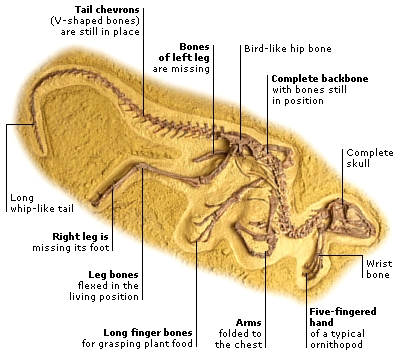DK Science: Body Fossils
Palaeontologists can have a hard time finding and identifying dinosaur fossils because they are usually embedded in stone. Usually, only the hard parts of the animal have been fossilized, and even then, a complete skeleton is rare – isolated bones and teeth are more common. Now and again, however, particularly good fossils are unearthed: fossils of complete skeletons in their living position, fossil skin textures, or very occasionally, indications of soft anatomy. Rare though these finds are, there have been enough of them over the past two centuries to allow scientists to build up a good picture of how dinosaurs lived.
This Heterodontosaurus is a palaeontologist’s dream! A nearly complete dinosaur skeleton, still articulated (with its joints in position), and in the pose of a living animal is an unusual find. It is possible to imagine this rabbit-sized plant-eater skipping along, head up and alert, tail swinging out behind. Unfortunately, a skeleton as well preserved as this is very rare. Usually, the bones are pulled apart and scattered by animals, bad weather, or flowing water. Most dinosaur fossils are fragments of bones or incomplete skeletons. The skull is so lightweight that it has nearly always collapsed into shards or is missing altogether.
Teeth are particulary hard and last well. They are covered in a substance called enamel that makes them even harder than bone. Teeth may fossilize when the bone of the animal is lost. Often the teeth are all that is found of a dinosaur, and some species are known from their teeth alone. The carnivorous theropods shed their teeth and grew new ones throughout their lives, so theropod teeth, such as those of the dinosaur Megalosaurus, are common.
Skulls of dinosaurs are not often found by palaeontologists. The skull is made up of many different sections all joined together, and soon after death most skulls come apart. Each side of a skull has about a dozen individual bones and, not counting the teeth, each lower jaw has three – four in the ornithischians. Many dinosaur skeletons have been found that are almost complete but lack the skull – arguably the most important part of the animal’s anatomy.
Dinosaur “mummies” have been created after dead dinosaurs were washed into a river and lay in soft mud before they decayed. The soft mud takes the impression of the skin texture and this is preserved when the mud solidifies to stone. These skin impressions are immensely valuable because they give scientists an idea of what the outer covering of a dinosaur would have looked like. However, they can also be misleading. For decades, the shrivelled skin of one hadrosaur’s hand gave rise to the idea that the fingers were webbed and that the hadrosaurs were swimming animals. The first evidence that dinosaur skin was similar to that of today’s reptiles comes from a mummified Edmontosaurus carcass, found in Wyoming, USA.
To order this book direct from the publisher, visit DK's website.

